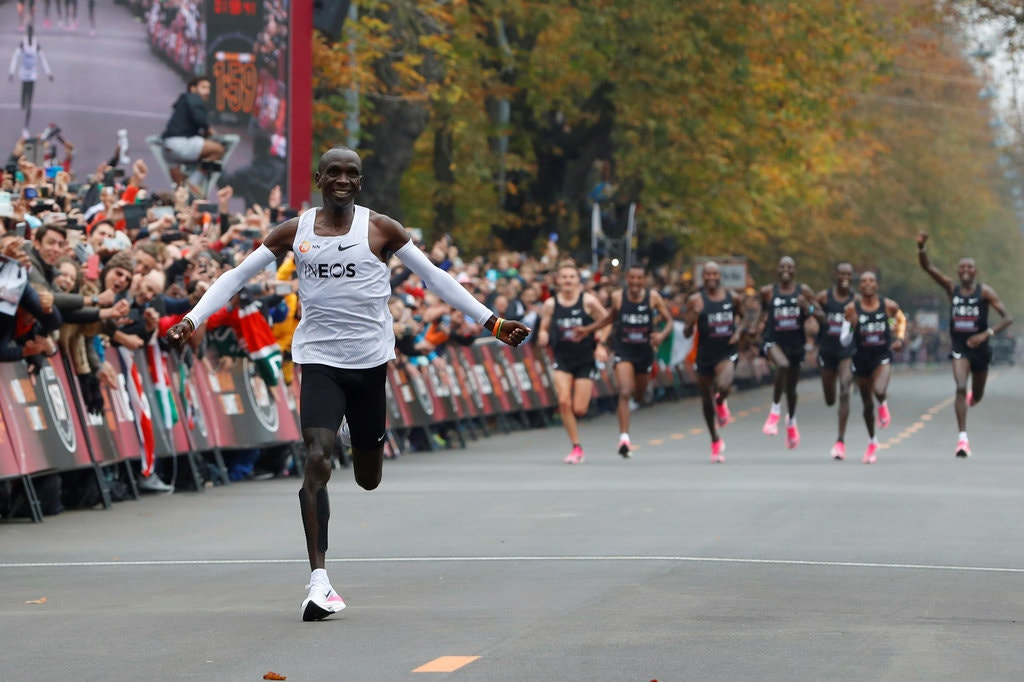Kenyan Runner Eliud Kipchoge Breaks The Two-Hour Marathon
A new record, but unfortunately it won't be recognized.

Kenyan distance runner Eliud Kipchoge became the first person to break the two-hour marathon, but his record isn’t going to count:
VIENNA — On a misty Saturday morning in Vienna, on a course specially chosen for speed, in an athletic spectacle of historic proportions, Eliud Kipchoge of Kenya ran 26.2 miles in a once-inconceivable time of 1 hour 59 minutes 40 seconds.
In becoming the first person to cover the marathon distance in less than two hours, Kipchoge, 34, achieved a sports milestone granted almost mythical status in the running world, breaking through a temporal barrier that many would have deemed untouchable only a few years ago.
Kipchoge, an eight-time major marathon winner and three-time Olympic medalist, pounded his chest twice as he crossed the finish line in Vienna’s leafy Prater Park, where the majority of the run had unfolded on a long straightaway of recently paved road, with roundabouts on either end.
Cheered on by a thick crowd of spectators, he was lifted into the air by members of his team, including the 41 professional runners who had acted as pacesetters during the run.
For Kipchoge, the feat merely burnished his credentials as the world’s greatest marathoner.
“Together, when we run, we can make this world a beautiful world,” Kipchoge said after finishing.
For all its magnitude, the accomplishment will be regarded largely as a symbolic one. The eye-popping time, which was 10 seconds quicker than the 1:59:50 time Kipchoge and his team had set out to achieve, will not be officially recognized as a world record because it was not run under open marathon conditions and because it featured a dense rotation of professional pacesetters.
What the event lacked in officially sanctioned gravitas, though, it seemed determined to make up for with theater and grandiose proclamations.
It’s too bad that Kipchoge’s achievement won’t be officially recognized, but he has proven that a marathon can be run in under two hours. Presumably, he should be able to do it in a sanctioned event as well.






Forget most people, most runners can’t keep up a 13.1 mph pace for 60 seconds, that dude did it for 2 hours.
13.1 miles an hour? Hell, I do that all the time on the 101, on the 5, on the 10, on the 405. . .
@Michael Reynolds:
Also Santa Monica Boulevard. But only off-peak.
@Michael Reynolds: “13.1 miles an hour? Hell, I do that all the time on the 101, on the 5, on the 10, on the 405. . .”
In your dreams. I left LA seven years ago, and even back then anything more than 10 mph on the 10 or the 405 was only possible between two and three am…
I have always been fascinated by the dependence of distance runners on the runners around them. You would think that endless hours of practice would create a “muscle memory” of the desired pace — but it’s clearly not true. One of the reasons times in Olympic distance races are typically so bad (compared to ordinary competitions) is that there aren’t any rabbits in the field; every runner is intending to finish the race.
The real breakthrough will be the mental breakthrough that allows some future runner to run as if those pacemaking teammates were cycling through, even when running solo.
(The absence of a dense pack of runners at the start, getting in each others’ way, is also a factor but one I have little sympathy with. There’s no reason a serious marathon couldn’t use staggered starts, the way time trials in bicycle road races are done.)
@wr:
I’m having the perfect LA morning. The air smells of smoke and an LAPD helicopter’s been circling Silver Lake blasting instructions to someone on the ground to lie down.
Checking one of the nosy neighbor apps it seems it was some Star Wars cosplayers, and Bobba Fett had a toy gun.
Come on, you miss it, dontcha?
@Michael Reynolds:
I love how “cosplay” is just a perfectly cromulent word now and everyone understands it.
Another way of looking at this is that he ran a mile in 4 minutes and 34 seconds and then he ran 25.2 more at the same rate.
Jesus.
@DrDaveT: There’s a reduction in aerodynamic drag, too, when you’re surrounded by pacers. That may not be as big a factor as the actual pace-keeping, but it’s noticeable for a marathon distance at this speed.
EDIT: I just read that the formation of pacers around Kipchoge is estimated to have shaved about one minute off his time. Note: it is still an incredible achievement.
@de stijl:
As is “cromulent”!
@de stijl: @Franklin:
Sometimes it goes the other direction, generationally. I did a double-take when my eldest starting using ‘grok.’
You know, there is not an animal on the planet that can outrun a human being. Oh, sure, over a short distance on a sprint, but over distance, none. And that’s how we hunted back in the day (and the Bushmen of Africa still do): Wound them, and then run them down. They don’t stand a chance.
@DrDaveT:
Running long distances is very much a mental exercise as well, which means runners “push” each other. But it’s still true that an elite marathoner can set a specific pace and maintain it within a couple seconds per mile, even if so far ahead of other runners that they are essentially running alone.
For example, just today the women’s marathon world record–which had stood since 2003–was surpassed by Brigid Kosgei, who knocked nearly a minute and a half off Paula Radcliffe’s time. Kosgei finished nearly seven minutes ahead of the second-place runner, so she was probably out front by herself for miles. Yet her half-marathon splits were 1:06:59 for the first half and 1:07:05 for the second. She was an utter metronome.
I think all the elites can do that. It’s uncanny how consistent their mile splits are.